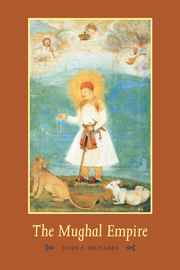Book contents
- Frontmatter
- Contents
- List of maps and tables
- General editor's preface
- Preface
- Introduction
- 1 Conquest and stability
- 2 The new empire
- 3 Autocratic centralism
- 4 Land revenue and rural society
- 5 Jahangir 1605–1627
- 6 Shah Jahan 1628–1658
- 7 The War of Succession
- 8 Imperial expansion under Aurangzeb 1658–1689
- 9 The economy, societal change, and international trade
- 10 Maratha insurgency and Mughal conquest in the Deccan
- 11 The Deccan Wars
- 12 Imperial decline and collapse, 1707–1720
- Conclusion
- Glossary
- Bibliographic essay
- Index
- THE NEW CAMBRIDGE HISTORY OF INDIA
8 - Imperial expansion under Aurangzeb 1658–1689
Published online by Cambridge University Press: 28 March 2012
- Frontmatter
- Contents
- List of maps and tables
- General editor's preface
- Preface
- Introduction
- 1 Conquest and stability
- 2 The new empire
- 3 Autocratic centralism
- 4 Land revenue and rural society
- 5 Jahangir 1605–1627
- 6 Shah Jahan 1628–1658
- 7 The War of Succession
- 8 Imperial expansion under Aurangzeb 1658–1689
- 9 The economy, societal change, and international trade
- 10 Maratha insurgency and Mughal conquest in the Deccan
- 11 The Deccan Wars
- 12 Imperial decline and collapse, 1707–1720
- Conclusion
- Glossary
- Bibliographic essay
- Index
- THE NEW CAMBRIDGE HISTORY OF INDIA
Summary
Aurangzeb remained a remarkably vigorous ruler for a half century (1658–1707) before he died at age ninety. During the first twenty years of his reign the emperor kept his capital at Shahjahanabad Delhi. In the next decade the grand encampment became the movable capital of the empire as the emperor campaigned actively in Rajasthan and the Deccan. Throughout the first thirty years of his reign Aurangzeb, who had added “Alamgir” or “world-seizer” to his titles, dedicated himself to fostering a more properly Islamic regime and to aggressive expansion on the empire's frontiers. However, several unrewarding campaigns in the 1660s and 1670s beyond the mountain rim of the subcontinent graphically revealed the harsh costs to further expansion in the north. These campaigns reinforced the emperor's pronounced inclination to move south – to conquer lands long accustomed to Islamic rule.
TESTING THE LIMITS OF EMPIRE: NORTHEAST
To the northeast, Bengal's growing export economy and Muslim settler frontier seemed a likely area for aggressive campaigning. Imperial authority still rested lightly in this region. When Prince Shuja's governorship of Bengal was interrupted by the succession war, zamindars like Prem Narayan, the ruler of Kuch Bihar, rebelled. Simultaneously, Jayadhwaj Sinha, the Ahom king, sent an army to invade and annex Kamrup, the Mughal border district on the Brahmaputra river.
In mid 1660, Aurangzeb, determined to regain control of the northeast, appointed Muhammad Said Mir Jumla, his collaborator in the Deccan, to be governor of Bengal, Bihar, and Orissa.
Keywords
- Type
- Chapter
- Information
- The Mughal Empire , pp. 165 - 184Publisher: Cambridge University PressPrint publication year: 1993

